新湘教版六年级下册英语教案
- 格式:pdf
- 大小:71.04 KB
- 文档页数:35
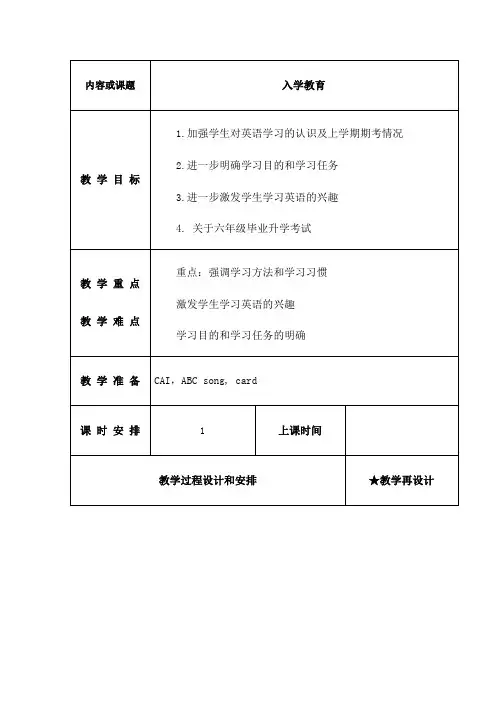
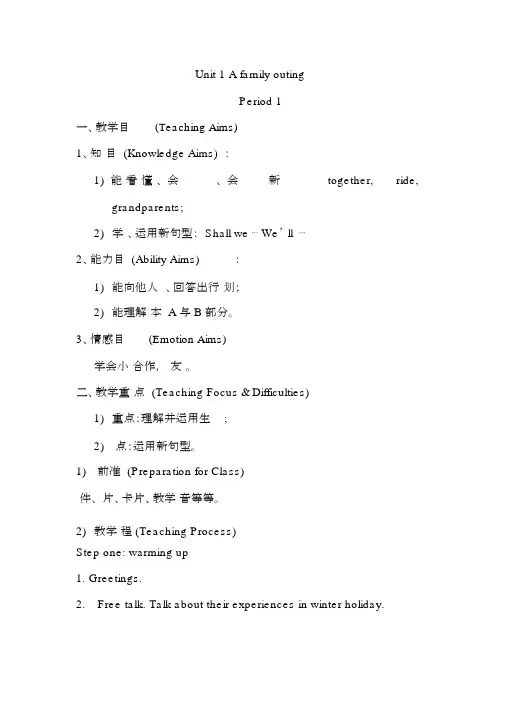
Unit 1 A family outingPeriod 1一、教学目(Teaching Aims)1、知目 (Knowledge Aims) :1) 能看懂、会、会新together,ride,grandparents;2)学、运用新句型: Shall we ⋯ We’ ll ⋯2、能力目 (Ability Aims):1)能向他人、回答出行划;2)能理解本 A 与 B 部分。
3、情感目(Emotion Aims)学会小合作,友。
二、教学重点 (Teaching Focus & Difficulties)1)重点:理解并运用生 ;2)点:运用新句型。
1)前准 (Preparation for Class)件、片、卡片、教学音等等。
2)教学程 (Teaching Process)Step one: warming up1. Greetings.2.Free talk. Talk about their experiences in winter holiday.Step two: presentationIntroduce new words and phrases.T: Do you want to do these things? Watch a movie? Go shopping? Take/ have a walk? Look at the flowers? I think, it is happy for us to do things together.Play games. I do, you say. Then I say, you do.The dialogue.Listen and find out who they are.Listen and read. Answer the question: what are Lingling’s family going to do?Listen and repeat.Listen and act.Step three: consolidation1.Talk about what you are going to do this evening.2.Talk about your plans to travel at weekend with yourpartner and act it out.1.Listen and read Part A and B.2.Copy the new words three times.五、板书设计(Blackboard Design)Unit 1 A family outingtogetherridegrandparents 教学反思:Period 2一、教学目(Teaching Aims)1、知目 (Knowledge Aims) :1) 能看懂、会、会新together,ride,grandparents;2)学、运用新句型: Shall we ⋯ We’ ll ⋯2、能力目 (Ability Aims):1)能向他人、回答出行划;2)能理解本 D部分的内容。

湘教版小学六年级英语下册教案Unit 1 You are good at drawing, Peter.Period 1Teaching aims:1.Ss can be confident in English studying.2.Enable the Ss to listen, read, say and write the new words: diving, pictures, good idea, watching films.3.Enable the Ss to be familiar with the sentence pattern: I like doing sth. I’m good at…Teaching emphasis:Enable the Ss to listen, read, say and write the new words.Teaching difficulties:Enable the Ss to be familiar with the sentence pattern: I like doing sth. I’m good at…Teaching tools:Tape, picturesTeaching methods:Task teaching method, Audio-linguistic method.Teaching steps:Step 1 Warming up1.Greetings.2.Make a conversation with the Ss.3.Play a game--- Doing and say.Eg: swimming, running…I like swimming. I’m good at swimming.Step 2 Presentation and drill1. Show the picture of “diving” .T: I like diving. I’m good at diving.The Ss read after the T: Diving, diving, diving.T: Can you spell the word “ diving”, please?T: I like drawing. I’m good at drawing.Show some pictures, and learn the word.2. Learn the other words in the similar way.3. Read together.4. Little teacher.Step 3 Practice1. T: I don’t like running. I like swimming. I’m good at swimming.S1: I don’t like swimming. I like skating. I’m good at skating.…2. The Ss act and say.3. Pair-work.4. Act it out.Step 4 Consolidation1.Evaluation.2.Do Ex.3.Homework. Copy the new words. Design of the blackboard:Unit 1 You are good at drawing, Peter. pictures good idea watch a filmI 'm not good at skating.I’m good at swimming.you are good at drawing, Peter.Unit 1 You are good at drawing, Peter.Period 2Teaching aims:1.Ss can get fun from English studying.2.Enable the Ss to listen, read and say the dialogue.3.Ena ble the Ss to master the sentence pattern: like doing sth, don’t like doing sth. Be good at doing…Teaching emphasis:Enable the Ss to listen, read and say the dialogue.Teaching difficulties:Enable the Ss to master the sentence pattern:like doing sth,don’t like doing sth.Be good at doing…Teaching tools:Tape, pictures, computer.Teaching methods:Task teaching method, Audio-linguistic method.Teaching steps:Step 1 Warming up1.Greetings.2.Act and say.T: I don’t like running. I like swimming. I’m good at swimming.S1: I don’t like swimming. I like skating. I’m good at skating.…Step 2 Presentation and drill1.Ask and answer:T: What do you like doing, Peter?Peter: I like reading. I don’t like singing.2. Listen to the tape and answer the questions.What is Anne like doing?What is Peter like doing?What is Lingling like doing?What is Mingming like doing?3. Explain the difficulties.Step 3 Practice1. Listen to the tape and repeat.2. Read after T.3. Read together.4. Pair-work.5. Little teacher.Step 4 Consolidation1.Evaluation.2.Do Ex.3.Homework.Design of the blackboard:Unit 1 You are good at drawing, Peter.What do you like doing, Peter?I like reading.I don’t like singing.I’m good at swimming.Period 3Teaching aims:1.Enable the to Ss talk about themselves happily.2.Enable the Ss to make sentences about themselves;3. Educate the Ss to finish the Ex.Teaching emphasis:Enable the Ss to talk about themselves.Teaching difficulties:Enable the Ss to finish the Ex.Teaching tools:Tape, computer.Teaching method:Task teaching method, Audio-linguistic method. Teaching steps:Step 1 Warming up1. Greetings.2. Read Part A together.Step 2 Presentation and drill1. T: Now please finish Part D: Talk about ourselves.2. Check the answer.3. Ask two Ss to retell the story.Step 3 Practice1. Class work. Look at the pictures, describe what each person is doing.2. What are they doing? Write sentences about 5 of the above pictures. Write the number of the picture in each box.3. Let’s sing.4. Let’s find out and write. The children are going to the cinema to watcha film. Draw lines to show how they go to the cinema. Write sentences to show how they go there.Step 4 Consolidation1.Do Ex. Workbook Unit 1.2.Evaluation.3.Homework. Revise Unit 1.Design of the blackboard:Unit 1 You are good at drawing, Peter.He is good at running.Jane is good at writing.Sally likes playing football.Period 4Teaching contents :Theme : You’re good at drawing ,Peter.Function: To know the grammar of how to use patterns :1)be good at …, 2) like doing…..Language : What are you good at?I am good at swimming.I am not good at singing.V ocabulary: diving, pictures, skating, good idea, watching films Teaching steps:1.Greetings :a)Good morning/afternoon boys and girls. How are you? Are you happy today ? What’s the weather like today? The Ss greet me at the same time . And answer my questions in correct way.b)Now ,who is on duty today ? The two students will give the class a duty talk that prepared by themselves .2.Warmer:1) Let’s to visit our old friends Lingling, Mingming, Peter and Anne. (CAI SHOWS )2) Review the verbs that we have learnt last term : run, eat, jump, swim, sit, draw, sing, etc.3.Presentation : Activity 1.Part B --let’s learn .1)Play the cassette of the words in Part B . The children listen.2)Play the CAI and ask the Ss to read the words after it several times. Then pause after each word for the Ss , then they read after it.3)Recite: This time ask Ss to recite the words as much as they can . And only give them 2 minutes . Then ask some of them to recite the words and as much as they can. If they also can act the words ,I will give thema praise.4)CAI shows some present participle words ,and ask the pupils to compare them with common verbs .Run Swim Jump sing drawRunning Swimming Jumping singing drawing5)Then lead in the grammar :I like doing sth. out. And give them some examples. Ex: I like swimming.Activity 2.Part A --- Let’s listen and say .Play the cassette and ask the Ss to listen the dialogue twice. Then ask them to answer the questions about the dialogue. It means to understand the dialogue quite well. The questions are:How many persons are there in this dialogue?What was Mingming not good at?Who was good at diving?What did Peter like doing? Etc.Then play the cassette again and ask them to listen once more.3)Explain the sentences if it is necessary .4)Then ask the Ss to read the story several times till fluently .5)Then CAI shows the questions again and ask the Ss to write the answers of questions on the notebook.6)Let the Ss to read their answers and then check the answers together.7)Ask several students to act the story out.Activity 3.Part C ---About the story.1) Ask the pupils to open their books and finish the questions in pairs.4.Homework : 1)Ask them to write 6 times for each word in the exercise book.2)Listen to tape several times at home and finish the exercise of Part F。
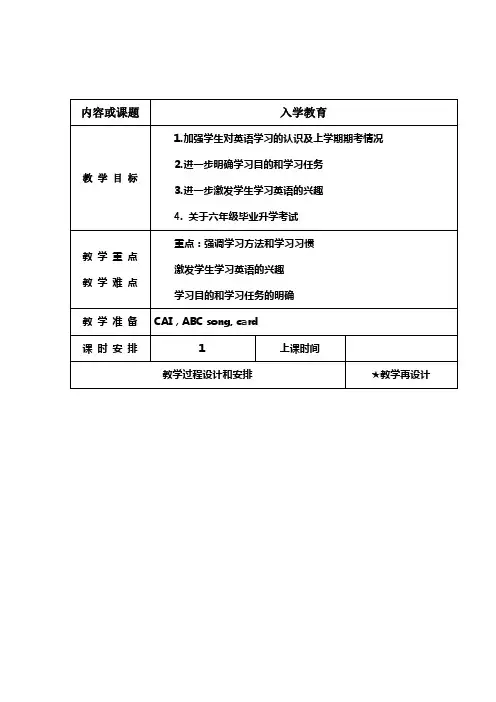
六年级下期英语导学案
六年级下期英语导学案
六年级下期英语导学案
六年级下期英语导学案
六年级下期英语导学案
六年级下期英语导学案
六年级下期英语导学案
六年级下期英语导学案
六年级下期英语导学案
六年级下期英语导学案
六年级下期英语导学案
六年级下期英语导学案
六年级下期英语导学案
六年级下期英语导学案
六年级下期英语导学案
六年级下期英语导学案
六年级下期英语导学案
总第节
六年级下期英语导学案
总第节。
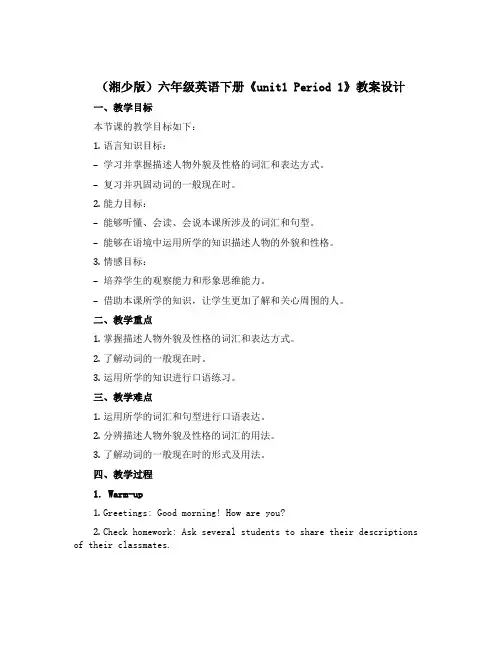
(湘少版)六年级英语下册《unit1 Period 1》教案设计一、教学目标本节课的教学目标如下:1.语言知识目标:–学习并掌握描述人物外貌及性格的词汇和表达方式。
–复习并巩固动词的一般现在时。
2.能力目标:–能够听懂、会读、会说本课所涉及的词汇和句型。
–能够在语境中运用所学的知识描述人物的外貌和性格。
3.情感目标:–培养学生的观察能力和形象思维能力。
–借助本课所学的知识,让学生更加了解和关心周围的人。
二、教学重点1.掌握描述人物外貌及性格的词汇和表达方式。
2.了解动词的一般现在时。
3.运用所学的知识进行口语练习。
三、教学难点1.运用所学的词汇和句型进行口语表达。
2.分辨描述人物外貌及性格的词汇的用法。
3.了解动词的一般现在时的形式及用法。
四、教学过程1. Warm-up1.Greetings: Good morning! How are you?2.Check homework: Ask several students to share their descriptions of their classmates.2. Presentation1.Introduce the target vocabulary: appearance, personality, hair, eyes, nose, mouth, ears, tall, short, thin, heavy, funny, kind, serious, friendly, shy, confident, active, lazy.2.Show pictures of people with different appearances and personalities, and ask students to describe them in pairs.3. Practice1.Play a game: Simon says. For example,。
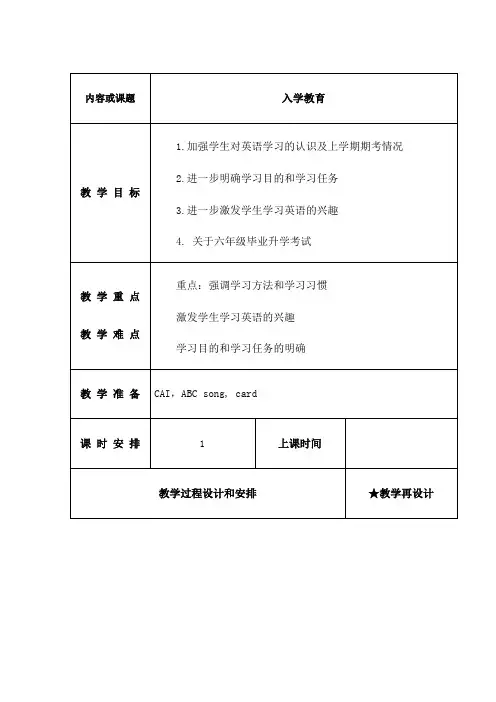

新版湘少版六年级英语下
册全册教案
The pony was revised in January 2021
六年级下期英语导学案
六年级下期英语导学案
六年级下期英语导学案
六年级下期英语导学案
六年级下期英语导学案
六年级下期英语导学案
六年级下期英语导学案
六年级下期英语导学案
六年级下期英语导学案
六年级下期英语导学案
六年级下期英语导学案
六年级下期英语导学案
六年级下期英语导学案
六年级下期英语导学案
六年级下期英语导学案
六年级下期英语导学案。
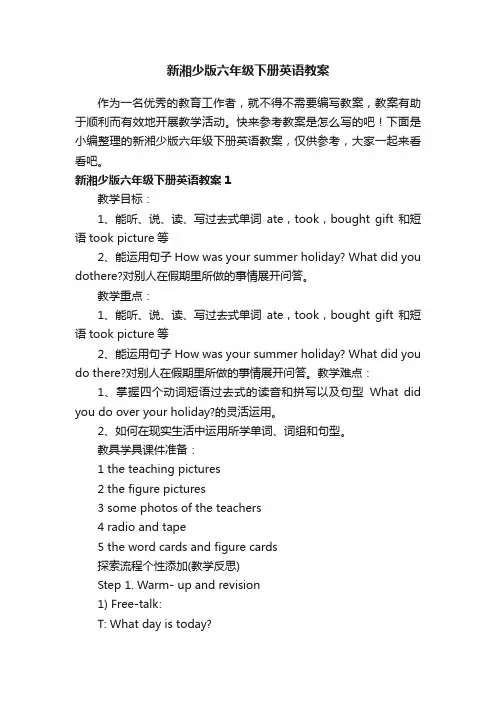
新湘少版六年级下册英语教案作为一名优秀的教育工作者,就不得不需要编写教案,教案有助于顺利而有效地开展教学活动。
快来参考教案是怎么写的吧!下面是小编整理的新湘少版六年级下册英语教案,仅供参考,大家一起来看看吧。
新湘少版六年级下册英语教案1教学目标:1、能听、说、读、写过去式单词ate,took,bought gift和短语took picture等2、能运用句子How was your summer holiday? What did you dothere?对别人在假期里所做的事情展开问答。
教学重点:1、能听、说、读、写过去式单词ate,took,bought gift和短语took picture等2、能运用句子How was your summer holiday? What did you do there?对别人在假期里所做的事情展开问答。
教学难点:1、掌握四个动词短语过去式的读音和拼写以及句型What did you do over your holiday?的灵活运用。
2、如何在现实生活中运用所学单词、词组和句型。
教具学具课件准备:1 the teaching pictures2 the figure pictures3 some photos of the teachers4 radio and tape5 the word cards and figure cards探索流程个性添加(教学反思)Step 1. Warm- up and revision1) Free-talk:T: What day is today?A: Today is…T: What day was yesterday? (强调yesterday)B: Yesterday/ It was…T: What did you do yesterday?C: I (did)…yesterday. (用前几课时已经学的词组)2) Chain-drill:C: I (did)…yesterday. What did you do yesterday?D: I (did)…yesterday. What did you do yest erday?E, F…( ask the teacher)T: I went to a park yesterday.Step 2. Presentation1) Let’s learn:继续Chain-drill,由T引出并出示新授词组:went hiking.2)学生已经了解了go的过去式后, T边用I went (这个动词用动作表示)yesterday.表达自己昨天去做什么了,边做动作.让学生帮老师说出: went swimming, wentfishing.3)Ask and answer:A: T ask and Ss answer.B: S1 ask and S2 answer.C: S3 ask and T answer.由此,T引出新授词组: read a book.4)自编chant. Chant together.见附录5)Listen to the tape and repeat. Pay attention to the pronunciation of:went, read.6)Reading in 2 parts: T say the phrase loudly, Ss say it lowly; T say thephrase lowly, Ss say it loudly.Step 3. Consolidation通过各种游戏,操练所学词组Activity 1找搭档Activity 2我是侦察兵Activity 3记忆大挑战Task-time1) Pair workA: What did you do last weekend? / Did you …?B: I (did)…/ Yes, I did.2)在问答过程中完成书中所示的表格.3)邀请几组同学到前面汇报调查结果板书设计作业布置Unit 3Last weekend1.听本部分的录音,读给朋友或家长听。
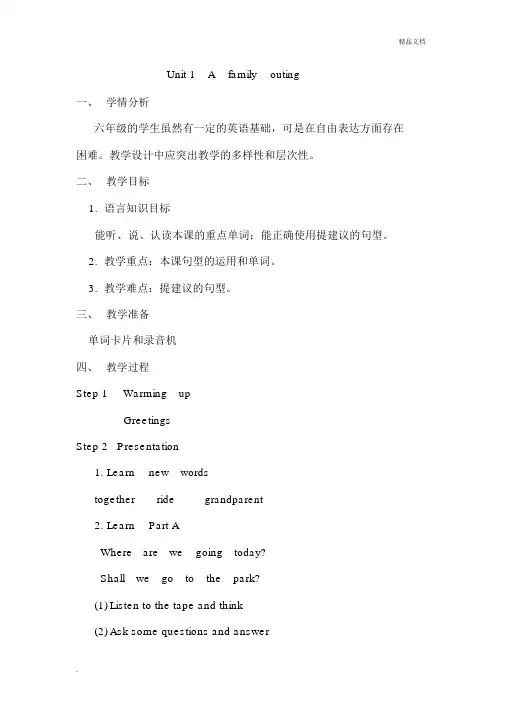
Unit 1 A family outing一、学情分析六年级的学生虽然有一定的英语基础,可是在自由表达方面存在困难。
教学设计中应突出教学的多样性和层次性。
二、教学目标1.语言知识目标能听、说、认读本课的重点单词;能正确使用提建议的句型。
2.教学重点:本课句型的运用和单词。
3.教学难点:提建议的句型。
三、教学准备单词卡片和录音机四、教学过程Step 1 Warming upGreetingsStep 2 Presentation1. Learn new wordstogether ride grandparent2. Learn Part AWhere are we going today?Shall we go to the park?(1)Listen to the tape and think(2)Ask some questions and answer(3)Listen and repeat(4)Teach the textStep 3 Practice1.Practise Part B2.Practise Part CStep 4 Consolidation总结本课。
Step 5 Summary评价学生本节课的表现。
Step 6HomeworkUnit 1 A family outing一、教学目标1.语言知识目标能记住本课单词并会默写;能正确使用提建议的句型。
2.教学重点:本课句型的运用和单词。
3.教学难点:句型的运用和语法。
二、教学准备图片、阅读材料和录音机三、教学过程Step 1 Warming up1.Greetings2.ReviewStep 2 Presentation1.Teaching Part DLet’s ReadRead the text and answer the questions.2.Teaching Part ELet’s WriteWrite down your answers.(1) What does your family usually do at weekends?(2) Where does your family usually go at weekends?Step 3 PracticePractise Part FLet’s Have FunLet’s sing a songStep 4Consolidation 总结本节课。

新版湘少版六年级英语
下册全册教案
YUKI was compiled on the morning of December 16, 2020
六年级下期英语导学案
六年级下期英语导学案
六年级下期英语导学案
六年级下期英语导学案
六年级下期英语导学案
六年级下期英语导学案
六年级下期英语导学案
六年级下期英语导学案
六年级下期英语导学案
六年级下期英语导学案
六年级下期英语导学案
六年级下期英语导学案
六年级下期英语导学案
六年级下期英语导学案
六年级下期英语导学案
六年级下期英语导学案
六年级下期英语导学案。
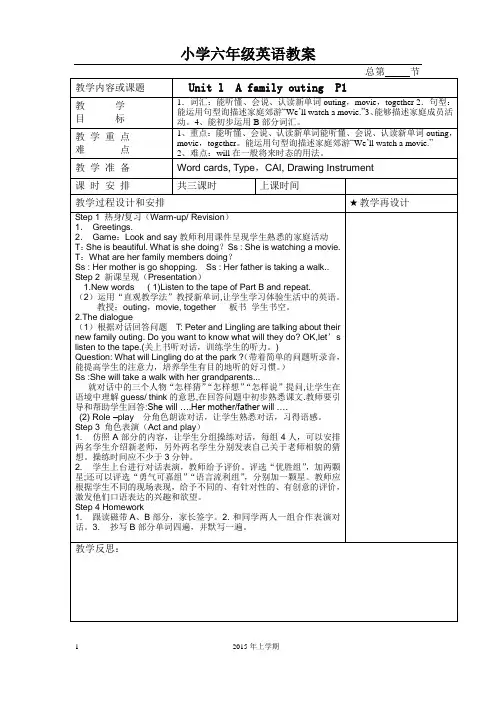
Unit 1 A family outingPeriod 1一、教学目标 (Teaching Aims)1、知识目标(Knowledge Aims):1)能看懂、会读、会说新单词together, ride,grandparents;2)学习、运用新句型:Shall we… We’ll…2、能力目标(Ability Aims):1)能向他人询问、回答出行计划;2)能理解课本A与B部分。
3、情感目标 (Emotion Aims)学会小组合作,团结友爱。
二、教学重难点(Teaching Focus & Difficulties)1)重点:理解并运用生单词;2)难点:运用新句型。
1)课前准备(Preparation for Class)课件、图片、卡片、教学录音等等。
2)教学过程 (Teaching Process)Step one: warming up1. Greetings.2. Free talk. Talk about their experiences in winter holiday.Step two: presentationIntroduce new words and phrases.T: Do you want to do these things? Watch a movie? Go shopping? Take/ have a walk? Look at the flowers? I think, it is happy for us to do things together.Play games. I do, you say. Then I say, you do.The dialogue.Listen and find out who they are.Listen and read. Answer the question: what are Lingling’s family going to do?Listen and repeat.Listen and act.Step three: consolidation1. Talk about what you are going to do this evening.2. Talk about your plans to travel at weekend with your partner and act it out.Step four: homework1. Listen and read Part A and B.2. Copy the new words three times.五、板书设计 (Blackboard Design)Unit 1 A family outingtogetherridegrandparents 教学反思:Period 2一、教学目标 (Teaching Aims)1、知识目标(Knowledge Aims):1)能看懂、会读、会说新单词together, ride,grandparents;2)学习、运用新句型:Shall we… We’ll…2、能力目标(Ability Aims):1)能向他人询问、回答出行计划;2)能理解课本D部分的阅读内容。
湘少版小学英语六年级下册精品教案(全册)Unit 1 You are good at drawing, Peter.Period 1 Teaching aims1.The aim of knowledge :New words and phrases: pictures、good idea、 watch a film.2. The aim of abilities : Understand part B and read in English fluently and freely.3. The aim of emotion : Making the students have successful feeling and achievement. And making them be in English study.Teaching important points It’s the pronunciation of the words and phrases. The students can master understand and use them.Teaching difficult pointsThe same to the above.Teaching methodsTPR, object teaching, playing games and so on.Teaching aidsRecorder, cards.Teaching proceduresss' activitiesStep 1 Warming up1. Greetings2. Sing an English song: Happy New Year.3. Free talk.Step 2 Presentationa. Teaching the word: pictureT: Show a picture, then say:Please look at me ,what’s this? Oh, it’s a picture. Show many pictures, one picture, two pictures, three pictures.New let’s count the pictures: one picture, two pictures, three pictures.b. Teaching the phrase : good ideaI meet a difficult thing, think and think, suddenly I open big eyes, because I have a good idea.c. Teaching the phrase : watch a filmDo you like to watch ? It’s a film. Now let’s watch the film ,OK?Step 3 Practice.Game 1. Happy passing.The student tells the word to the next one in a soft voice , then oneby one. The last one speak out the word loudly. Who is right,who is the winner.Game 2. Find a friend.Game 3. Quick response.Please look at my hands. And speak out the words and phrases quickly.Step 4 Consolidation.Listen to part B.Step 5 Exercises.Copy the words and phrases:picture, good idea, watch a filmGreetingSingingTalkingLookingGameBlackboard Design:Unit 1 You are good at drawing, Peter.picture---picturesgood ideawatch a filmPostscript:The students can’t go into the status of the new semester at the beginning of term . I must awaken the passion of students to learn English through a variety of ways.Period 2Teaching aims1. The aim of knowledge :Master the drills:be(not) good at + v-ing2. The aim of abilities :Understand and read part A.3. The aim of emotion :Talk about their hobbies.Teaching important points The students can master understand part A and use the sentences: What do you like doing? I’m good at drawing. I’m not good at skating.Be(not) good at+v-ingTeaching difficult pointsThe same to the above and listening.Teaching methodsSimulated -Scene, Hearing methods, Communicative method.Teaching aidsRecorder, cards.Teaching procedures:ss' activitiesStep 1.Warming up.1. Greetings.2. Free talk.Step 2. Review.Going over the learned words and phrases: pictures, good idea, watch a film.Step 3.Presentation and drill.1. Making Simulated –Scene:This is Anne's home. There are some children here. They are talking something. What are they talking about? Please listen.2. Learn some sentences:What do you like doing ?I am good at swimming.I am not good at swimming.Make a example like the above:I’m (not) good at running/skating/drawing/singing…2. For each activity,T helps Ss to make some sentences as the examples.Step 4.Practice .1. Listen to the recorder and read after it three times.2. Read Part A by themselves for five minutes.3. Role play Part A.Step 5.Consolidation.1. Listen and write.2. Homework.GreetingTalking.ListeningActingBlackboard Design:Unit 1 You are good at drawing, Peter.What do you like doing ?I like drawing.I’m good at drawing.I’m not good at skating.[Be(not) good at+v-ing.Postscript:Period 3Teaching aims1. The aim of knowledge : Master the key drills: be(not)good at+ving. Make sentences about yourself.2. The aim of abilities : Listen to the tape, improve the students’ listening.3. The aim of emotion :Talk about their hobbies.Teaching important points The students can master understand the parts:Part C. About the story.Part D .Let’s practice.Part E .Let’s write.Part F .Let’s listen and write.Teaching difficult points The students can use the knowledge.Teaching methods Communicative method.Teaching aids Recorder, cards.Teaching procedures:ss' activitiesStep 1.Warming up.1. Greetings.2. Free talk.3. Role play Part A.Step 2. PresentationⅠ.Answer questions:1.What is Anne good at? She is good at swimming.2. What does Mingming like doing? He likes skating.3. What does Peter like doing? He likes drawing.4. What do all the kids like? They like watching films.Ⅱ.Pairs work:1. What are you good at ?2. What are you not good at ?3. What is your best friend good at ?4. What do you like doing?5. Do you like watching films?Ⅲ.Look at the picture in P3,make a example like the following:e. g. I am good at swimming. I am not good at swimming.1. I am good at jumping.2. I am good at playing table tennis.3. I am good at singing.4. I am good at fishing.5. I am good at drawing.Ⅳ.Listen to the tape carefully and fill in the blank on P4.Step 3.Practice .Step 4.Consolidation.3. Listen and write.4. Homework.Step 5 Sum upGreeting--Talking.----ActingAnsweringAsk and answerBlackboard Design:Unit 1 You are good at drawing, Peter.Be(not) good at+vingPostscript:Unit 2 Anne wanted to skate.Period 1Teaching aims1. The aim of knowledge : Master new words and phrases: skating, rink, learn, fall over, fell over, keep straight, try.2. The aim of abilities : Learn to master these words and expressions.3. The aim of emotion :The students like to study English.Teaching important points The students can use the words and phrases:skating, rink, learn, fall over, fell over, keep straight,Teaching difficult points The same to above.Teaching methods Reading. Logical Memorial Method of English Words.Teaching aids Recorder, cards.Teaching procedures:ss' activitiesStep 1. Warming up1. Greeting.2. Free talk.3. Sing a song: Do Re MeStep 2. Review1. Reading Part A of Unit 1.2. Recite the learned words and expressions.Step 3. Teaching new words.1. Read Part A. Understand it for the first time. Find out new works and phrases.2. Teaching the new words and phrase:a. Skating rinkDrawing a rink. A boy is skating in the skating rink. Tell the students: This is a skating rink.b. LearnLearn from Lei Feng.Live and learn. 活到老,学到老By do we learn. 边做边学c. Teaching the phrase: fall overfall---fellThe teacher acts an old woman, walk slowly, then fall to the ground. I say to myself “I am old , sometimes I fall to the ground.”d. keep straight [streit]Keep your back straight. 挺直你的背Stand up straight.Sit down straight.e. try toPlease try to come. 请你尽可能来。
Unit 1 A family outing一、学情分析六年级的学生虽然有一定的英语基础,可就是在自由表达方面存在困难。
教学设计中应突出教学的多样性与层次性。
二、教学目标1.语言知识目标能听、说、认读本课的重点单词;能正确使用提建议的句型。
2.教学重点:本课句型的运用与单词。
3.教学难点:提建议的句型。
三、教学准备单词卡片与录音机四、教学过程Step 1 Warming upGreetingsStep 2 Presentation1.Learn new wordstogether ride grandparent2.Learn Part AWhere are we going today?Shall we go to the park?(1)Listen to the tape and think(2)Ask some questions and answer(3)Listen and repeat(4)Teach the textStep 3 Practice1.Practise Part B2.Practise Part CStep 4 Consolidation总结本课。
Step 5 Summary评价学生本节课的表现。
Step 6 HomeworkUnit 1 A family outing一、教学目标1.语言知识目标能记住本课单词并会默写;能正确使用提建议的句型。
2.教学重点:本课句型的运用与单词。
3.教学难点:句型的运用与语法。
二、教学准备图片、阅读材料与录音机三、教学过程Step 1 Warming up1.Greetings2.ReviewStep 2 Presentation1.Teaching Part DLet’s ReadRead the text and answer the questions、2、Teaching Part ELet’s WriteWrite down your answers、(1)What does your family usually do at weekends?(2)Where does your family usually go at weekends?Step 3 PracticePractise Part FLet’s Have FunLet’s sing a songStep 4 Consolidation总结本节课。
Step 5 Summary评价学生本节课的表现。
Step 6 HomeworkUnit 2 Some stories are more interesting、一、学情分析六年级的学生虽然有一定的英语基础,可就是在自由表达方面存在困难。
教学设计中应突出教学的多样性与层次性。
二、教学目标1、语言知识目标能听、说、认读本课的重点单词;能正确使用提建议的句型。
2、教学重点:本课句型的运用与单词。
3、教学难点:提建议的句型。
三、教学准备单词卡片与录音机四、教学过程Step 1 Warming upGreetingsStep 2 Presentation1、Learn new wordsmeat a piece of happily its woodcross drop lose2、Teaching Part A(1) Listen to the tape and think、(2) Ask some questions and answer、(3) Listen and repeat、(4) Teach the text、Step 3 Practice1.Practise Part B、2.Practise Part C、Step 4 Consolidation总结本节课。
Step 5 Summary总结本节课学生的表现。
Step 6 HomeworkUnit 2 Some stories are more interesting、一、教学目标:1、能记住本课单词并会默写;能正确使用形容词的比较级。
2、教学重点:本课句型的运用与单词。
3、教学难点:句型的运用与语法。
二、教学准备图片、阅读材料与录音机三、教学过程:Step 1 Warming UpGreetings and reviewStep 2 Presentation1.Teaching Part DLet’s ReadRead the text and answer the questions、2.Teaching Part ELet’s WriteFill in the blanks、(1)What kind of books does Peter like?Peter likes 、(2)What books does Anne like?Anne likes 、(3)What books does Lingling like?She likes 、(4)Who likes reading science books and fairy tales?likes reading science books and fairy tales、Step 3 PracticePractise Part FLet’s Have FunStep 4 Consolidation总结本节课Step 5 Summary评价学生的学习Step 6 HomeworkUnit 3 We should learn to take care of ourselves一、学情分析六年级学生在自由表达方面存在困难,教学设计中应突出教学的多样性与层次性。
二、教学目标1、语言知识目标能听、说、认读本课的重点单词;能正确使用情态动词。
2、教学重点:本课句型的运用与单词。
3、教学难点:情态动词的运用。
三、教学准备单词卡片、录音机四、教学过程Step 1 Warming UpGreetingsStep 2 Presentation1.Teaching new words、take care of healthy keep exercise jog2.Teaching Part A(1)Listen to the tape、(2)Ask some questions and answer、(3)Listen and repeat、(4)Teach the text、(5)Read by yourself、Step 3 Practice1.Read Part B、2.Practise Part C、Step 4 Consolidation总结课文Step 5 Summary评价学生的学习Step 6 HomeworkUnit 3 We should learn to take care of ourselves一、教学目标1、语言知识目标能记住本课单词并会默写;能正确使用情态动词。
2、教学重点:本课句型的运用与单词。
3、教学难点:句型的运用与语法。
二、教学准备图片、阅读材料与录音机三、教学过程Step 1 Warming Up1.Greetings2.ReviewStep 2 Presentation1.Teaching Part DRead the text and answer the questions、2.Teaching Part EWrite down your answers、(1)How old are you?I’m 、(2)Where do you go for your exercise?I do exercise 、(3)What do you have for lunch?I have 、(4)What do you do to be happy?I 、Step 3 PracticeLet’s Have FunSing the song “This Is the Way”Step 4 Consolidation总结本节课Step 5 Summary评价学生本节课的学习Step 6 HomeworkAssessment Ⅰ一、教学目标1、语言知识目标了解更多锻炼知识;复习前3课所学知识。
2、教学重点:前3课所学语法。
3、教学难点:句型的运用与语法。
二、教学准备图片、录音机三、教学过程Step 1 Warming Up1.Greetings2.ReviewStep 2 Presentation1.Learn “Let’s Know More”Exercise is good for our health、2.Learn Part A and Part B、Listen and tick、Listen, number and sayStep 3 Practice1.Do Part CRead, write and talk2.Do Part DRead and write、3、Do Part E and Part F、Step 4 Consolidation总结本课Step 5 Summary评价本节课学生的学习Step 6 HomeworkUnit 4 Planting trees is good for us一、学情分析六年级学生在自由表达方面存在困难,教学设计中应突出教学的多样性与层次性。
二、教学目标1、语言知识目标能听、说、认读本课的重点单词;能正确使用动名词作主语。
2、教学重点:本课句型的运用与单词。
3、教学难点: 动名词的运用。
三、教学准备单词卡片、录音机四、教学过程Step 1 Warming UpGreetingsStep 2 Presentation1.Teaching new words、Tree Planting Day air place2.Teaching Part A(1)Listen to the tape(2)Ask questions and answer(3)Listen and repeat(4)Teach the text、Step 3 Practice1.Read Part Bplant trees keep the air clean keep us cool make the place beautiful2.Practise Part CStep 4 Consolidation总结本节课Step 5 Summary评价学生本节课的学习Step 6 HomeworkUnit 4 Planting trees is good for us一、教学目标1、语言知识目标能记住本课单词并会默写;能正确使用动名词。
2、教学重点:本课句型的运用与单词。
3、教学难点:句型的运用与语法。
二、教学准备图片与阅读材料三、教学过程Step 1 Warming Up1.Greetings2.ReviewStep 2 Presentation1.Teaching Part DRead the text and do the exercises、2.Teaching Part EComplete the table、Why do people cut down trees?Why should we plant more trees?Step 3 PracticeLet’s Have FunWhat can you see in the tree?Step 4 Consolidation总结本节课Step 5 Summary评价学生本节课的学习Step 6 HomeworkUnit 5 Our Earth looks like this in space一、学情分析六年级学生在自由表达方面存在困难,教学设计中应突出教学的多样性与层次性。